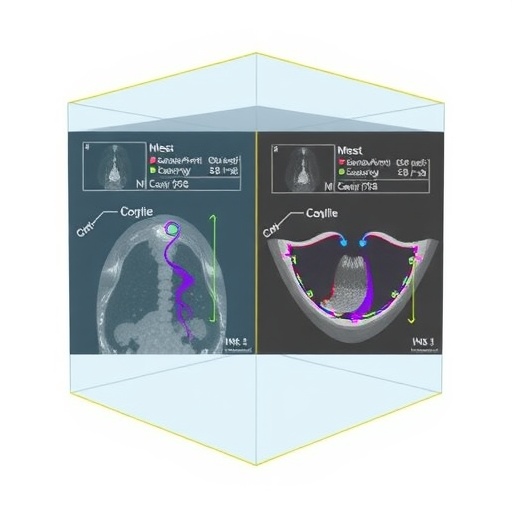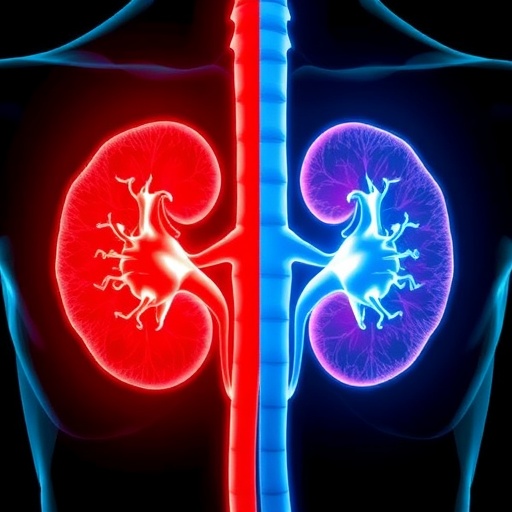In a groundbreaking advancement in surgical imaging technology, researchers have developed a novel transparent ultrasound transducer array designed to revolutionize lymphovenous anastomosis (LVA) microsurgery. This innovative device integrates clinical ultrasound, photoacoustic, and fluorescence imaging modalities into a single platform, allowing surgeons unprecedented real-time visualization capabilities during complex microsurgical procedures. The synergy of these imaging techniques promises to enhance precision and outcomes in the treatment of lymphedema, a chronic and debilitating condition caused by lymphatic system dysfunction.
Lymphovenous anastomosis microsurgery involves the delicate reconnection of lymphatic vessels to nearby veins to restore lymphatic drainage, thus alleviating lymphedema symptoms. However, the intricate nature of lymphatic anatomy and the challenges in distinguishing lymphatic vessels from surrounding tissues have historically impeded the success and reproducibility of this procedure. Traditional imaging guidance techniques often fall short in providing the spatial resolution and multimodal contrast needed for optimal vessel identification and manipulation.
The study led by Park et al. presents a transparent ultrasound transducer array that represents a paradigm shift in intraoperative imaging. Unlike conventional opaque ultrasound transducers, this transparent variant allows simultaneous optical imaging methods—specifically, photoacoustic and fluorescence imaging—to be employed through the same device. Photoacoustic imaging leverages the photoacoustic effect, whereby pulsed laser light induces ultrasonic waves via thermoelastic expansion in tissue chromophores, providing high-resolution vascular imaging. Fluorescence imaging, on the other hand, uses fluorescent dyes that selectively accumulate in lymphatic vessels, enabling clear visualization with molecular specificity.
By integrating these three complementary imaging modalities, the transparent ultrasound transducer array offers a unified imaging approach that enhances the identification and demarcation of lymphatic vessels from adjacent veins and tissues. This integration is critical because it delivers anatomical and functional information simultaneously, which is vital for precise anastomosis. The transparent design also mitigates shadowing artifacts and permits seamless optical access during ultrasound imaging, overcoming a significant limitation of existing approaches.
The technical details of this transducer array reveal an intricate balance between optical transparency and acoustic sensitivity. The array is fabricated using piezoelectric materials and conductive electrodes optimized for minimal light obstruction while maintaining efficient ultrasound signal generation and reception. The device operates within clinically relevant frequency ranges, ensuring compatibility with standard ultrasound imaging systems. Moreover, its transparent nature allows excitation laser light to pass through for photoacoustic and fluorescence imaging without compromising ultrasound performance.
In practical surgical settings, this device empowers surgeons with multimodal real-time feedback. The ultrasound component provides structural information and tissue depth, while photoacoustic imaging highlights vascular networks based on optical absorption contrasts, and fluorescence imaging identifies lymphatic-specific markers. This combination enables the differentiation between lymphatic vessels and veins, facilitates the identification of functional lymphatic valves, and guides the placement of precise anastomotic sutures.
The research team conducted extensive ex vivo and in vivo studies to validate the performance and clinical utility of the transparent ultrasound transducer array. Their experiments demonstrated superior vessel delineation and enhanced visualization of lymphatic fluid flow compared to conventional imaging approaches. Notably, the multiplexed imaging platform significantly reduced surgery times and improved postoperative outcomes in animal models, indicating promising translational potential.
Beyond the immediate application in LVA surgery, the transparent ultrasound transducer array holds broad implications for microsurgical procedures that demand high-precision guidance. The platform’s versatility in combining optical and acoustic imaging makes it a potential game-changer in fields such as oncology, where distinguishing tumor margins from healthy tissue is critical, or in vascular surgeries requiring detailed vessel mapping.
The integration of photoacoustic and fluorescence imaging within a transparent ultrasound array represents a synthesis of optical and acoustic methodologies that harness their respective strengths. Photoacoustic imaging’s deep tissue penetration complements fluorescence imaging’s molecular specificity, while ultrasound provides essential anatomical context. Their harmonious overlap within a single device addresses longstanding challenges inherent in multi-imaging system synchronization and alignment.
Furthermore, the device’s transparent form factor has ergonomic and practical advantages for surgeons, who often struggle with bulky imaging probes and complex device switching during operations. By offering a cohesive imaging window, the transparent transducer reduces operational complexity, minimizes tissue manipulation, and enhances surgical workflow efficiency—a critical factor for patient safety and surgical success.
This pioneering work exemplifies an ongoing trend toward multimodal imaging integration in biomedical engineering and surgical innovation. As advanced imaging technologies mature and converge, the potential for enhanced diagnostic accuracy, treatment personalization, and minimally invasive interventions grows exponentially. The transparent ultrasound transducer array serves as a tangible milestone in this trajectory, illustrating how materials science, photonics, and acoustics can coalesce to solve pressing clinical challenges.
Looking forward, the research team envisions further enhancement of the device’s sensitivity and miniaturization to facilitate deployment in more confined anatomical regions. Additionally, the incorporation of artificial intelligence algorithms for image interpretation and automated guidance could augment surgeon decision-making, making procedures like LVA safer and more accessible globally.
In summary, the transparent ultrasound transducer array devised by Park et al. stands as a transformative innovation in surgical imaging. By uniting ultrasound, photoacoustic, and fluorescence imaging within one transparent device, it promises to elevate the precision and efficacy of lymphovenous anastomosis microsurgery. This advancement not only holds immediate clinical significance for lymphedema treatment but also opens avenues for broader applications in microsurgery and image-guided interventions, marking an exciting horizon in medical technology.
Subject of Research: Development of a transparent ultrasound transducer array for multimodal imaging-guided lymphovenous anastomosis microsurgery
Article Title: Clinical ultrasound, photoacoustic, and fluorescence image-guided lymphovenous anastomosis microsurgery via a transparent ultrasound transducer array
Article References:
Park, J., Oh, D., Yoo, J. et al. Clinical ultrasound, photoacoustic, and fluorescence image-guided lymphovenous anastomosis microsurgery via a transparent ultrasound transducer array. Nat Commun 16, 9853 (2025). https://doi.org/10.1038/s41467-025-64827-8
Image Credits: AI Generated
DOI: https://doi.org/10.1038/s41467-025-64827-8
Tags: enhancing surgical precisionfluorescence imaging techniquesintraoperative imaging innovationslymphatic system dysfunction solutionslymphedema treatment advancementslymphovenous anastomosis surgerymicrosurgery imaging challengesmultimodal imaging in microsurgerynovel surgical transducer designphotoacoustic imaging applicationsreal-time surgical imagingtransparent ultrasound technology





